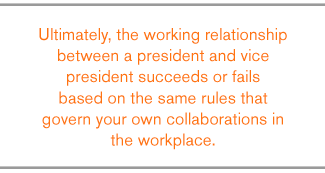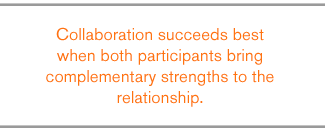So Barack Obama picked Joe Biden to be the Democratic vice presidential nominee, and John McCain picked Sarah Palin to complete the Republican ticket. Big deal. Why should we care?
 |
Let's be honest. For all the co-branding of McCain/Palin and Obama/Biden as though each ticket belonged together like Lewis and Clark, working partnerships between U.S. presidents and their vice presidents are quite rare. Odds are that after the inauguration, we won't see much of whichever running mate gets elected.
But why not? Why haven't there been more memorable partnerships between president and vice president? The answer to that question illuminates not just lost opportunities in governing the United States, but the reasons why your own partnerships in business may falter.
Who needs a vice president?
At various points in history -- and for a total of nearly 34 years -- the United States didn't even have a vice president. After succeeding the assassinated William McKinley in 1901, Theodore Roosevelt was without a vice president until his second term, as was Harry Truman after succeeding Franklin Delano Roosevelt. John Tyler never had a vice president. Nor did Chester A. Arthur.
John Adams, the nation's first vice president and second president, found the vice presidency "the most insignificant office that ever the invention of man contrived or his imagination conceived." Truman is reported to have said the chief responsibilities of the vice president were to "go to weddings and funerals."
McCain himself, when asked in 2000 whether he would accept second billing on the Republican ticket, said, "I would not under any circumstances consider being vice president of the United States. The vice president has two duties. The first is to inquire daily as to the health of the president, and the other is to attend the funerals of Third World dictators."
But that's not how the office is being pitched at this stage of the campaign. Both camps clearly believe that at least the appearance of a partnership is good for business.
Obama said, before announcing his choice, that he was looking for "somebody who can help me govern. I'm not interested in a vice president who I just send off to go to funerals. I want somebody who's going to be able to roll up their sleeves and really do some work." When Obama introduced Biden as his running mate, he endorsed him as "uniquely suited to be my partner as we work to put America back on track."
At the Republican convention, McCain proclaimed, "I've found just the right partner to help me shake up Washington." Within weeks, the Republican camp broadcast TV ads showing its candidates side by side as "the original mavericks." "They'll make history," the deep-voiced narrator intones. "They'll change Washington."
But to the degree that history is a guide, the odds are against whichever ticket wins becoming a strong partnership in office. "Once the election is over, the vice president's usefulness is over," an aide to Vice President Hubert Humphrey once said. "He's like the second stage of a rocket. He's damn important going into orbit, but he's always thrown off to burn up in the atmosphere." In recent administrations, Vice Presidents Al Gore and Dick Cheney have come closer to being partners to their presidents.
Ultimately, the working relationship between a president and vice president succeeds or fails based on the same rules that govern your own collaborations in the workplace. Partnerships like Obama/Biden or McCain/Palin won't ever be more than a pairing on a bumper sticker without adhering to the following rules, and neither will the partnership between You/Your Partner.
A common mission
No partnership succeeds unless it is founded on a mission shared by both people. This may seem basic, but it was an oversight of the founding fathers, who made the vice presidency an office assumed by the runner-up to the presidency. Had the 12th Amendment not corrected this problem in 1804, we might have had Al Gore and John Kerry as vice president to George W. Bush, Bob Dole as vice president to Bill Clinton, or Walter Mondale to Ronald Reagan. It might make for great political theater, but it's not a formula for collaboration.
Although running mates now come from the same party, it's much easier to share the common mission of defeating the other ticket than, once in office, to share a vision for governing the country. In particular, that mission must be meaningful enough for both people that they will subordinate their personal agendas to the common good. Thrown together by party politics or in trying to appeal to swing voters, many presidents and vice presidents, once in power, were hamstrung by the desire of the president to govern without interference and by the vice president's designs on the higher office.
 |
The questions you and your collaborator need to ask are: Do you agree on a particular shared accomplishment? Do you both want to achieve it so much that you will make the necessary personal sacrifices? If you can't answer yes to both questions, you have no partnership.
Complementary strengths
Collaboration succeeds best when both participants bring complementary strengths to the relationship. Both McCain and Obama implicitly acknowledged this by picking running mates who fill in for their weak spots. Obama, a historic yet relatively inexperienced candidate, went for Biden's greater experience. McCain, an experienced senator, got a historic candidate in Palin. Whether either pair would have complementary abilities in office -- for example, the deliberativeness of one balanced by the action orientation of the other -- remains to be seen.
In your own working relationships, you should constantly be looking for potential collaborators who have what you lack, and for those who lack what you have. If you don't really need the abilities of your counterpart, you run the risk of making him or her into what Dan Quayle once protested he was not -- a "potted plant."
Fairness
For a collaboration to succeed, it must be fair to both people. This does not mean it must be a 50/50 relationship, but the work and rewards must be proportionate. The Constitution puts a disproportionate amount of both work and reward on the president's shoulders. The vice president earns $221,100 per year; the president gets $400,000. A case could be made that the vice president has the better deal. By law, he or she need only preside over the Senate and be ready to assume the presidency if needed (and attend a few funerals, of course). Meanwhile, the president has responsibility for the entire executive branch of the federal government.
In practice, vice presidents are always at risk of being politically shut out. "I want to be Robin to [George H.W.] Bush's Batman," Dan Quayle once said. Thomas R. Marshall, vice president to Woodrow Wilson, once remarked, "Once there were two brothers. One ran away to sea; the other was elected vice president [of the United States]. And nothing was ever heard of either of them again." A partnership with the vice president requires the chief executive to delegate meaningful work and provide opportunity to earn political acclaim. The same is true of any partnership in which one person has disproportionate power and authority.
In your own partnerships, both partners should agree to the division of work and rewards. Each person needs to understand what his or her counterpart hopes to get from the deal, whether it's money, a chance at a promotion, or exposure to an important audience that could influence his or her career. The best partners work hard at ensuring that the other person is well-compensated for his or her contribution.
Trust
Trust is the glue that holds a partnership together. It takes a long string of cooperative overtures and reciprocation to create that glue. A bruising primary battle is hardly the best way to start an effective collaboration, which may be one of the reasons Obama didn't pick Hillary Clinton to be his vice president or why McCain did not pick Mitt Romney.
Both presidential contenders chose running mates with whom they have little history, positive or negative. There is no telling whether either of the current tickets will develop trust, because both pairs have had little time to be tested under pressure as yet. Both are politically expedient pairings and are very new relationships.
Reliable partnerships develop when both people put themselves at risk, assuming their counterpart will reciprocate and not take advantage of their vulnerability. In your own partnerships, the faster you can make and reciprocate cooperative gestures, the sooner both of you can stop watching your back and get on with the job at hand.
Communication
Communication is crucial to a partnership. For the president, there's no reason he can't stay in touch with his vice president, who has an office in the West Wing of the White House and an official residence not far away. But it's been an unwillingness to communicate, not distance, that has hampered past presidential pairs. Vice President Thomas Jefferson reported that he and President Adams had only a brief discussion about diplomatic posts at the beginning of the administration, then "he never after that said one word to me on the subject, or ever consulted me as to any measures of the government." At various points in history, the vice president has not even been invited to cabinet meetings.
 |
Most collaborators communicate too little. In the early stages, partnerships are endangered by silence, which creates doubts about trustworthiness. Later, when trust is established, too much silence reduces the degree of coordination between partners. Chances are, unless you have a steady flow of conversations between you and your counterpart, whether in person or by phone, text messages, or e-mail, you don't have a solid working partnership.
Mutuality
The most difficult quality for any partnership to attain is "mutuality." This term describes the moment at which both people become nearly as concerned for the other person as they are for themselves. This quality has been particularly elusive in politics, and there is scant evidence that it's ever been attained in the relationship between a president and vice president. There are hints of it in Garret Augustus Hobart being "assistant president" for a time to McKinley, Cheney serving George W. Bush with no personal aspiration to replace him, and what TIME magazine called Gerald R. Ford's "lack of jealousy in wielding power" with Nelson Rockefeller.
Because of the constitutional powers involved, the compact between running mates can be one of the most important collaborations in the world. Or -- because of the personalities involved -- it can be no working relationship at all. Your own potential partnerships likely won't have the weight of world-changing decisions placed on them, but in all other respects, they are the same. Like any collaborative opportunity, your partnership is what the two of you make of it.
Rodd Wagner and Gale Muller, Ph.D., recently completed five years of research identifying and analyzing the crucial dimensions of a successful partnership. They currently advise company executives and government leaders on how to strengthen collaboration within their organizations.